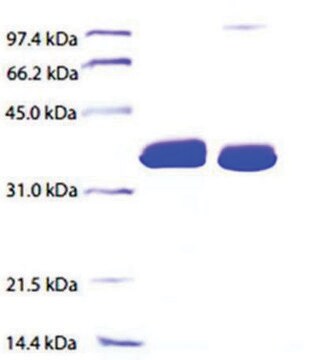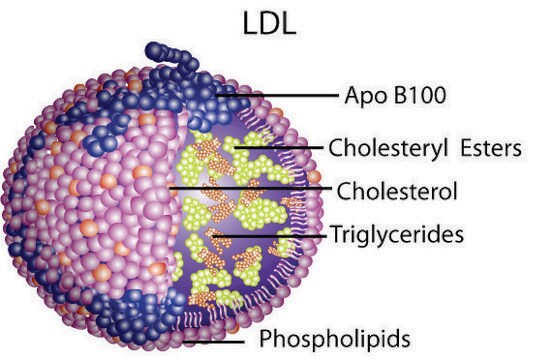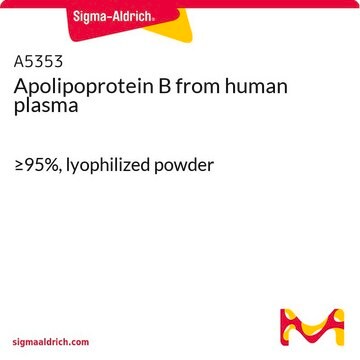178468
Apolipoprotein E, Human Plasma, Very Low-Density Lipoprotein
Native apolipoprotein E from human plasma. A major component of VLDL and IDL. Serves as a major cholesterol carrier. Essential for the normal catabolism of triglyceride-rich lipoprotein constituents.
Synonyme(s) :
Apo E
Se connecterpour consulter vos tarifs contractuels et ceux de votre entreprise/organisme
About This Item
Code UNSPSC :
12352202
Nomenclature NACRES :
NA.25
Produits recommandés
Niveau de qualité
Essai
≥95% (SDS-PAGE)
Forme
liquid
Fabricant/nom de marque
Calbiochem®
Conditions de stockage
OK to freeze
avoid repeated freeze/thaw cycles
Conditions d'expédition
wet ice
Température de stockage
−20°C
Description générale
Native apolipoprotein E from human plasma. A component of VLDL and of a subclass of HDL. Present in normal plasma at concentrations of 50 µg/ml. Serves as a ligand for LDL receptors, where it participates in the transport and redistribution of cholesterol and other lipids. Also functions in immunoregulation and cell growth differentiation. Inhibits mitogen-induced T-lymphocyte proliferation and modulation of smooth muscle cell differentiation.
Conditionnement
Please refer to vial label for lot-specific concentration.
Avertissement
Toxicity: Standard Handling (A)
Forme physique
In 50 mM NH₄HCO₃, pH 8.0.
Notes préparatoires
Prepared from plasma that has been shown by certified tests to be negative for HBsAg and for antibodies to HIV and HCV.
Reconstitution
Following initial thaw, aliquot and freeze (-20°C).
Autres remarques
Kelly, M.E., et al. 1994. Cell Immunol. 159, 124.
Mahley, R.W. 1988. Science 240, 622.
Rall, S.C., et al. 1986. Methods Enzymol. 128, 273.
Mahley, R.W. 1988. Science 240, 622.
Rall, S.C., et al. 1986. Methods Enzymol. 128, 273.
Informations légales
CALBIOCHEM is a registered trademark of Merck KGaA, Darmstadt, Germany
Clause de non-responsabilité
Ce produit, destiné à la recherche scientifique, est soumis à une réglementation spécifique en France, y compris pour les activités d′importation et d′exportation (Article L 1211-1 alinéa 2 du Code de la Santé Publique). L′acheteur (c′est-à-dire l′utilisateur FINAL) est tenu d′obtenir une autorisation d′importation auprès du ministère français de la recherche, mentionné à l′article L1245-5-1 II du Code de la Santé Publique. En commandant ce produit, vous confirmez détenir l′autorisation d′importation requise.
Code de la classe de stockage
11 - Combustible Solids
Classe de danger pour l'eau (WGK)
WGK 1
Point d'éclair (°F)
Not applicable
Point d'éclair (°C)
Not applicable
Certificats d'analyse (COA)
Recherchez un Certificats d'analyse (COA) en saisissant le numéro de lot du produit. Les numéros de lot figurent sur l'étiquette du produit après les mots "Lot" ou "Batch".
Déjà en possession de ce produit ?
Retrouvez la documentation relative aux produits que vous avez récemment achetés dans la Bibliothèque de documents.
Jian-Ying Zhou et al.
Journal of proteome research, 9(10), 5133-5141 (2010-08-12)
The discovery of biomarkers for neurodegenerative diseases will have a major impact on the efficiency of therapeutic clinical trials and may be important for understanding basic pathogenic mechanisms. We have approached the discovery of protein biomarkers for amyotrophic lateral sclerosis
Joanna L Richens et al.
International journal of molecular epidemiology and genetics, 5(2), 53-70 (2014-06-25)
Previous mass spectrometry analysis of cerebrospinal fluid (CSF) has allowed the identification of a panel of molecular markers that are associated with Alzheimer's disease (AD). The panel comprises Amyloid beta, Apolipoprotein E, Fibrinogen alpha chain precursor, Keratin type I cytoskeletal
Andrzej S Pitek et al.
PloS one, 7(7), e40685-e40685 (2012-07-26)
It is now well established that the surface of nanoparticles (NPs) in a biological environment is immediately modified by the adsorption of biomolecules with the formation of a protein corona and it is also accepted that the protein corona, rather
Notre équipe de scientifiques dispose d'une expérience dans tous les secteurs de la recherche, notamment en sciences de la vie, science des matériaux, synthèse chimique, chromatographie, analyse et dans de nombreux autres domaines..
Contacter notre Service technique








